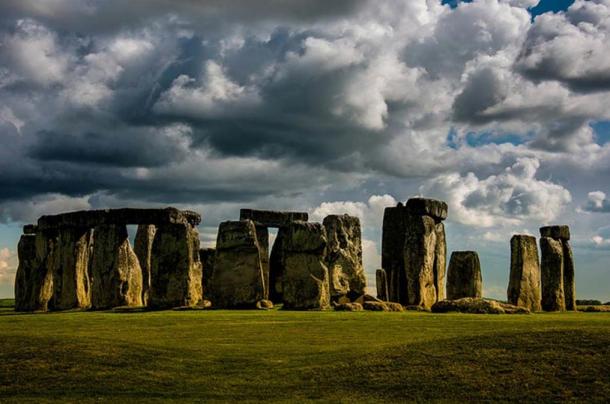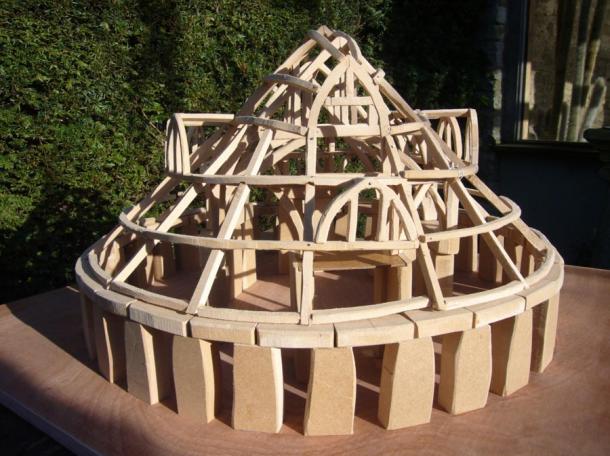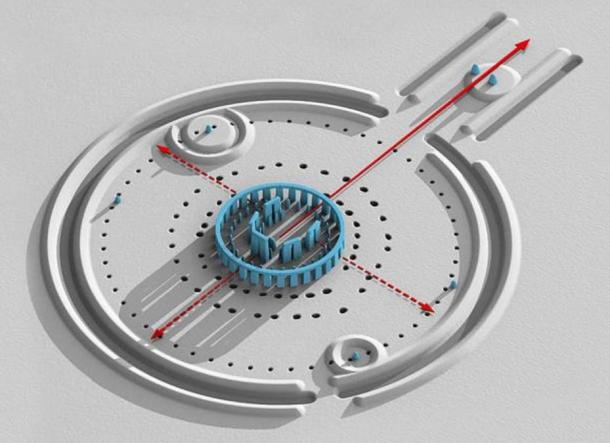
Architect presents radical new theory that Stonehenge was a two-storey, wooden feasting and performance hall
Could the prehistoric Stonehenge megaliths once have been the support for a wooden, two-storey roundhouse, a venue for feasting, speakers and musicians? That’s the theory of an English landscape architect who designed a small model of what she has in mind and is looking for money to build a 1:10 scale model of the structure.
Sarah Ewbank says the fact she is not an archaeologist has freed her from preconceived notions and allowed her to approach the matter in a fresh way.
Ms Ewbank told Ancient Origins via email about her vision of Stonehenge:
“I believe Stonehenge was a Bronze-age venue, a large oval hall encircled and overlooked by galleries. Interestingly the upper level was tiered, the height of different sections reflecting the different height trilithons. Consider both hall and galleries filled, listening to a speaker, or maybe there was feasting on the galleries with dancing below, perhaps crowds gathered to listen to singing or musicians playing, or maybe ceremonies took place to welcome in the solstices. It all sounds rather splendid and certainly needed – there were no electronic gadgets then!
My view – such a splendid building deserved to be used often – so, much as the Albert Hall in London serves to accommodate every type of gathering, so I believe our Bronze-age ancestors used Stonehenge whenever such a venue was required. Our bronze-age ancestors were intelligent people with needs similar to ours today. Forget the furry loin cloth and ritual sacrifice stuff - it's wrong.”
She said she’s discussed her theories with other experts. Some of them agree with her interpretation of the building’s use, but others strongly disagree and argue for the traditional view.

The way the monument looks today. Howard Ignatius/ Flickr
Ms. Ewbank speculates that the sides of the house were made of oak and the roof of thatching. Of course, it is highly unlikely wood or straw would survive the thousands of years of Stonehenge’s existence, so finding physical evidence for her theory—other than the layout of the stones themselves—is next to impossible.
In fact, she says on her website people have asked her if there is evidence of a roof. She points out that 500-year-old abbeys have roofs missing. “So don’t expect to find the timber structure lying around after 4,000 years,” she said.
“When you look at it the whole thing it fits absolutely perfectly,” she’s quoted as saying in SalisburyJournal. “I haven’t had to push one stone out of place. I have just taken all the standing stones and it all fits.”

Ms. Ewbank’s model without the roofing (Photo copyright Sarah Ewbank)
She lists several reasons on her website for theorizing the monument was a roundhouse, including:
- One of the stones is called the “lintel stone,” apparently for an important reason.
- The blue-stones have grooves in them for structural purpose.
- The trilithons are spaced just right to support four large trusses. The height difference between the trilithons allowed raising of the trusses.
Ms. Ewbanks writes on her blog:
To form the large trusses, only eight 15-baunt (16-metre) oak timbers with angled profile are required. Bronze-age oaks were very likely bigger and better than those available today. Apparently ship-building in past-times robbed the UK of the good-sized oaks! Before discounting this idea ask yourself, ‘If Bronze-age people are capable of quarrying, moving and shaping stones that weigh 20 to 50 tonnes, can they fell and oak and shape the timber to form a roof?’ The answer can only be yes.
She told SalisburyJournal:
“Archaeologists are very obsessed with dating and the meaning of it. I looked at it and thought it was a ruin, and that with my design skills I could work out what was there. In our climate back in the Bronze Age it still rained, and why would you move 75 large stones just so you could dance around twice a year? If you put a roof on it you can use it all year.”
And those ancient people apparently moved those stones quite a distance. Archaeologists announced in December 2015 that they found the exact holes in a rocky outcrop in Wales from where the bluestones found at Stonehenge originated, revealing that they were quarried 500 years before they were assembled into the famous stone circle that still stands today in Wiltshire, England. The dramatic discovery suggests that some of the stones making up the ancient monument was first erected as a structure in Wales and later dismantled, transported, and reassembled over 140 miles away in Salisbury Plain.

Computer rendering of the overall site of Stonehenge and surrounds. Public Domain
The Guardian reports that the finding was made during a project run by the University College London (UCL), in cooperation with the universities of Manchester, Bournemouth and Southampton, among others, to investigate quarries in the Preseli Hills in Pembrokeshire, Wales.
It has long been known that the bluestones – a term used in a loose sense to cover all of the ‘foreign’ stones which are not native to Salisbury Plain – originated in southwest Wales. Their name actually refers to the spotted dolerite, an igneous rock that looks blue when broken and is spotted with small pellets of feldspar and other minerals that got into the molten matrix when the rocks were forming geological ages ago. Nearly a century ago, in 1923, the eminent petrographer, Herbert Thomas, was able to identify their source as the Preseli hills .
Another scholar, Julian Spalding, theorized recently that the Stonehenge we know today may have been merely the support for a series of elevated wooden platforms. These platforms could have been used for spiritual ceremonies, elevating religious leaders off the ground - bringing humans closer to the heavens and the gods.
Art critic, historian and former curator Spalding said to The Guardian : “In early times, no spiritual ceremonies would have been performed on the ground. The Pharaoh of Egypt and the Emperor of China were always carried – as the Pope used to be. The feet of holy people were not allowed to touch the ground. We’ve been looking at Stonehenge from a modern, earth-bound perspective.”
No physical evidence has been found to back up the historian’s claim.
The exact purpose of Stonehenge is not known, but some researchers believe it was built as an ancient calendar to mark seasons and the movements of the sun and moon. Others say it was a place of healing, or dying, or perhaps a place of worship.
Featured Image: The famous Stonehenge monument in Wiltshire, England, as imagined in a 1:50 scale model made by landscape architect Sarah Ewbanks. (Image copyrighted by Sarah Ewbanks)
By Mark Miller
















Comments
Stonehenge is designed as part of the World zodiac. Our ancient predecessors studied the zones of the World and their unique animal features and recorded the World as anatomical parts, features of an image of the full body. Each zone was then projected to the corresponding zone of the sky, forming the constellations. The zodiac of Dendera marks the World zones and indicates the high latitude for the position of Stonehenge, Cancer.
The next zone East of Stonehenge is Egypt and the sphinx of Leo, the next zone East is Israel known as Virgo, next the scales and balancing pivotal point of karma and the Buddha.....The heads of Easter Island, each zone of the World has an historical, heritage record of each anatomical position of the World body.
These observation then correlate to the Celestial body, each anatomical part forms the full body of Nut (Egyptian) the Father (biblical) Ranginui (New Zealand)
Help. My latest posting appeared briefly on a Google search for STONEHENGE but was then quickly de-listed.
http://colinb-sciencebuzz.blogspot.co.uk/2016/05/its-time-to-get-real-ab...
Why? Maybe it was not a good idea to suggest, nay insist, that Stonehenge was designed for sky burial, aka excarnation. Maybe there are too many vested interests determined to maintain the received wisdom re Stonehenge (Neolithic temple, astronomical observatory etc). Maybe it was a mistake to rub salt in the wound by suggesting the same was true for Avebury and all the other stone circles (each megalith being a handy bird perch). What do you think, dear reader? Was I being OTT?
Reminder: the large collection of bones uncovered at Stonehenge were cremated (end-stage clean up post excarnation)?
Even Auntie BBC recognized that “Seahenge” – a simple timber circle – had been a site for excarnation.
http://news.bbc.co.uk/1/hi/sci/tech/388988.stm
If Seahenge, then why not Stonehenge?
ColinB
Part 2 reply to Patrick V:
Addressing your second point Patrick:
“I know about some tombs but is there any trace of bones graves around the site ? Then can we presume/speculate the bones, once defleshed, were later fetch for reburial or whatever... ?”
Bones? You betcha – lots and lots, not as complete skeletons or even individual intact bones, but masses of bone fragments – some 50,000 we’re told from 60 or more individuals. They were first discovered and disinterred at Stonehenge back in the 1920s, but no museum was interested in having them (unlike the Guernsey Museum that accepted 15kilos of EXCARNATED CREMATED bones in earthenware urns from the La Varde site - about which more later). So what happened to them? Wait for it – they were reburied would you believe it in one of the so-called Aubrey Holes aka pits in the 1930s, but were recently retrieved by Prof.Mike Parker-Pearson and his team, which was caught on camera.
https://www.youtube.com/watch?v=Xl6PaGi270Q
However his focus was on who or what the owners of those bones were in life 4.500 years ago – their gender, how many, diet, likely geographical origin, but thus far I see no evidence that consideration was given to whether the bones were from cremating excarnated skeletons or (as seem to be assumed, mistakenly I believe) whole bodies. That’s a pity because there are techniques for doing that, e.g. from looking at the colour, fracturing etc
Here’s a quote from the two researchers, one of whom I’ve made initial contact for more information:
It’s Chapter 2 in Tim Thompson’s “The Archaeology of Cremation, Burned Human Remains in Funerary Studies” (Oxbow Books, 2015, a copy of which I recently purchased online).
and entitled:
“Flesh,fire, and funerary remains from the Neolithic site of La Varde, Guernsey: Investigations past and present”.
By Jenny Cataroche and Rebecca Gowland
Reminder (if needed): “Very few of the burnt bones/fragments were oxidized to white and none showed evidence of the shrinkage, deformation or curved U-shaped fissuring that typically signal the high intensity burning of fleshed bodies (refs). Detectable fractures were in all cases linear, and transverse splintering was noted in several of the larger fragments (ref to Fig). These are features typically seen in cases where ‘dry’ bones have been burnt subsequent to the total, or near-total, decomposition of the soft tissues (refs).Rather than indicating standard cremation this evidence argues in favour of one or more burning events, in which the bones of deceased individuals were burnt post mortem and once decomposition was at a very advanced stage.”
Any peck marks on the bones? Sadly, there’s only two photos in the paper, one with a gnawed bone – an isolated finding – but interestingly the other is somewhat pitted in appearance - see this recent posting on my specialist Stonehenge /Silbury Hill site (Archive 4 at the end).
https://sussingstonehenge.wordpress.com/2016/04/17/might-the-standing-st...
I met Prof M P-P briefly at the highly publicized block-towing experiment last Monday week, and enquired whether he had considered that those bones could have been post excarnation or not (that was before discovering the Guernsey work with its seemingly neglected forensic technology). He didn’t comment directly, but said his research indicated that cremated remains had in his opinion been brought to Stonehenge from several distant parts of Britain. That was a bit of a conversation stopper, one I’m presently researching before renewing contact. Best for now to hold fire, no pun intended while I get my head round strontium isotope analysis etc, which may or may not be the basis of his claim. Frankly I think he has his priorities wrong, and should be focusing on proving/disproving sky burial first, before adducing other evidence that attempts to exclude Stonehenge as an excarnation or even cremation site. Why install all that megalithic masonry if it was simply a memorial site for folk cremated elsewhere? Is it possible that excarnation is still taboo subject in polite British society, not considered a suitable topic for after-dinner conversation – and that M P-P and the UK’s archaeology establishment, English Heritage especially - are all essentially trying desperately to look the other way?
Sorry, someone had to say it - but it won’t do my out-with-the-old, in-with-the-new topical issue science-based blogging credentials any harm to be the first, or maybe second if one includes a prescient (2014) paper by modern day send-off specialist Ken West MBE for the “Good Funeral Guide”....
http://www.goodfuneralguide.co.uk/2014/02/stonehenge-sky-burial/
Yup, I was discussing excarnation in respect of Durrington Walls and Silbury Hill, back in 2012, but decided to keep some seditious notions re jewel-in-the-crown Stonehenge largely to myself, except for:
“Did the iconic structure of Stonehenge – with those lintels especially – serve a utilitarian as well as ritual role – one that had been previously tested at Woodhenge, and then replicated in a form that was more durable, and resistant to fire, possibly attack also?” (June 2012):
https://sussingstonehenge.wordpress.com/2012/06/08/road-map-to-a-new-the...
ColinB
You make some interesting and indeed perceptive observations. Might I be allowed to respond to one point at a time?
You state:
“The upright stones, and especially level lintels of Stonehege, provided secure places on which scavenger birds – especially crows and seagulls – could perch, roost and maybe even nest.
-- bird shit are acidic/corrosive, this process should have left possible trace on the stone ?”
I have an answer for that, one I’m quite pleased about, since it provides a rationale for lugging all those “bluestones” 140 miles or so from Pembrokeshire in west Wales. Received wisdom is that those stones were valued on account of having “healing properties”. So what’s healing properties got to do, one might ask, with a “place of the dead” with any number of cremated human remains? Are “healing properties” really so important such that Neolithic man, without wheels, without horses, felt obliged to transport monoliths, each weighing several tons, all that distance, whether by lifting, dragging or a combination of the two over rough terrain, or risking sea and river transport?
I have an alternative explanation, one that addresses the very point you raised. It’s to do with keeping the “bird perches “, standing stones especially, looking clean and presentable for each new set of bereaved mourners, bringing their recently deceased member of the family along for ‘ritualised’ body disposal via “sky burial”.
“Bluestone”, not a recognized geological term according to Brian John (see his Stonehenge/Ice Age blog), differs primarily from the local sarsen sandstone of Salisbury Plain in being an IGNEOUS rock, i.e. formed by solidification of molten extruded magma, essentially volcanic in origin and thus close-grained, as distinct from sedimentary rock formed by deposition/cementation of particles of sand etc on a sea bed. The predominant mineral in the Stonehenge “bluestone” monoliths is spotted dolerite (the white flecks being mica inclusions) and as I recently demonstrated it is non-porous to water – it repels liquid water almost as if a modern plastic.
Link to my April posting
http://colinb-sciencebuzz.blogspot.co.uk/2016/04/why-need-for-all-those-...
It is that property I believe that was why it was so highly valued at a site for sky burial – it was much, much easier to keep clean than porous absorbent sandstone – simply splash with water. The birds probably appreciated having a clean perch too – especially if gulls and crows - maybe marginally more fastidious than your average Continental vulture. Thus the added hospitality in the form of elevated secure perches, either standing stonesas at Avebury, but Stonehenge’s high lintels especially, 5 star Michelin rating. That’s to say nothing of those peculiarly British easy-to-spot (bird’s eye view) stone-encircling henges carved into the white chalk and limestone of the southern English landscape. There’s never been a proper explanation for those either. I say they had scavenger bird appeal – from afar AND close-up, once the perches and free meal was eyed up. My money’s on gulls being the preferred species – they have amazing learning curves when it comes to free meals.
ColinB
Hi, this is interesting but i may have some questions. You may provide some explanation.
The upright stones, and especially level lintels of Stonehege, provided secure places on which scavenger birds – especially crows and seagulls – could perch, roost and maybe even nest.
-- bird shit are acidic/corrosive, this process should have left possible trace on the stone ?
-- I know about some tombs but is there any trace of bones graves around the site ? Then can we presume/speculate the bones, once defleshed, were later fetch for reburial or whatever... ?
Simple burial would have been laborious and time-consuming on the chalk uplands of Wiltshire (deer antler picks only!) and cremation probably seen as a criminal waste of firewood, needed for cooking and keeping warm.
-- But would it not be laborious and time-consuming to cut, move and build Stoneedge whit deer antler picks only ?
-- But would it not be laborious and time-consuming to travel many days to go place a corpse on the lintel then come back later fetch the Bones ?
Pages